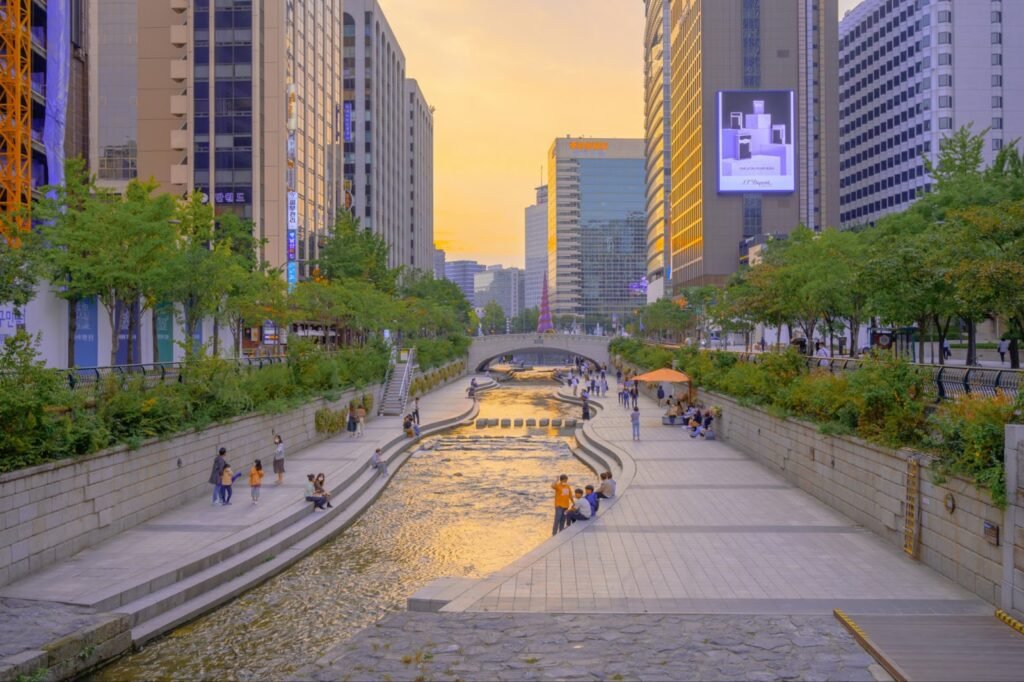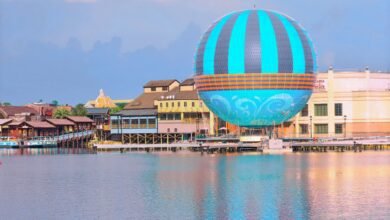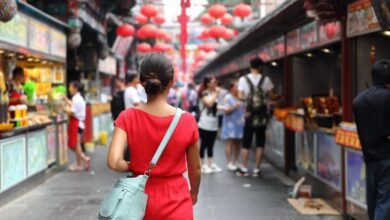There’s a rhythm to travelling through South Korea that you don’t realise you’ve fallen into until you’re halfway through a bowl of kimchi stew, sitting in a tiny train station café, watching clouds slide over green mountains. It’s not a loud rhythm. It’s not rushed. But it moves you, carrying you from one city to the next, from steam-filled street food stalls to peaceful palace gardens, with the low hum of a high-speed train stitching it all together.
This is a country where the past and present coexist quietly. You can sip cold barley tea in a centuries-old hanok house one moment and walk into a futuristic art museum the next. And thanks to the sleek, beautifully run KTX railway, you can go from north to south in the time it takes to watch a film and still have time to stop for dessert along the way.
In this article
From Seoul to Busan: Following the Tracks of Taste and Time
Seoul hits you like a shot of espresso. It’s bold, buzzing, and endlessly layered. Tall glass towers rise beside quiet neighbourhoods where ajummas (elderly women) tend rooftop gardens, and alleys bloom with tiny cafés that smell of cinnamon and old books. In the morning, the city hums with the sizzle of street food, egg bread, hotteok, and spicy rice cakes dished out with quiet precision.
But even in a city so alive, there comes a moment when you want a shift. That’s when you board the KTX Seoul to Busan, a journey that starts in the middle of Seoul’s whirlwind and ends, a few serene hours later, by the sea.
You barely notice the train picking up speed. One moment you’re waving goodbye to Seoul’s sprawl, and the next you’re gliding past misty rice paddies, sleepy villages, and the occasional glimpse of someone hanging laundry under the sun. It’s calm. It’s quiet. And strangely comforting.
And just like that, you arrive in Busan.

Busan: Where Salt Meets Spice
Busan feels like exhaling. There’s salt in the air and sand on your shoes, and everyone seems to walk just a little slower. Locals chat over seafood stews in alleyway restaurants, laughter mingling with the sharp scent of fermented crab and red pepper.
Here, food is briny, bold, and full of character, just like the city. You can taste the ocean in every bite. There’s grilled eel at Jagalchi Market, chewy bowls of milmyeon noodles tossed in a sweet-spicy sauce, and grilled clams served with soju and sea views. You’ll eat things you can’t quite name, and you won’t care, because it’s all cooked with heart and served with a smile.
In between meals, you might find yourself at Gamcheon Culture Village, where pastel-painted houses lean into each other on a hillside, or wandering the rocky paths around Haedong Yonggungsa Temple as waves crash below. It’s noisy, peaceful, messy, and beautiful all at once.
KTX: Fast Tracks, Quiet Moments
What makes the KTX Korea experience so memorable isn’t just the speed—it’s the way it allows you to move through the country without ever losing the thread of the journey. You’re not checking in hours early or staring at airport departure boards. You’re sitting by a window, watching the land unfold.
Trains glide from coast to city to countryside with quiet confidence. You pass forests that turn gold in autumn, mountains that feel ancient, and towns that flicker by like postcards.
It’s on these journeys between the stops where you have time to reflect. You catch yourself thinking about the soup you had in Seoul, or the stranger who helped you buy a bus ticket with a hand on your shoulder and a smile that said, “Don’t worry.” The train becomes a space to let it all settle. A moving pause.
Little Cities, Big Feelings
There’s a kind of magic in Korea’s smaller cities, the ones you might miss if you weren’t paying attention. Gyeongju is one of them. Once the capital of an ancient kingdom, it’s now a quiet town where grassy tombs rise like hills and temple bells echo through pine trees. You can rent a bike, ride through fields of lotus flowers, and feel like you’ve stepped into another century.
Then there’s Jeonju, home of Korea’s most celebrated bibimbap, a dish so lovingly assembled you’ll hesitate before digging in. The hanok village here is alive, not staged. Locals still live in the wooden homes. Children run barefoot across the stone paths. You sip makgeolli on a shady terrace, and the world slows.
These places remind you that travel isn’t always about chasing the “must-sees.” Sometimes it’s about finding a tiny backstreet where someone’s grandmother is still rolling rice cakes by hand, just as she’s done for decades.
The Language of Food
If Korea has a national language beyond Hangul, it’s food. Every meal is a conversation between regions, between generations, between you and the land. The spice level changes as you head south. The broth becomes heartier in the mountain towns. The banchan (side dishes) are never quite the same, even when the menu is.
One moment, you’re burning your mouth on a bubbling pot of kimchi stew in Daegu. Next, you’re sharing sweet pancakes filled with brown sugar on a rainy night in Jeonju, your fingers sticky and your heart full.
You don’t need a map to understand this country. Just follow the smells. Follow the warmth. Follow the queues.
Final Thoughts: The Joy of Slowing Down on the Fast Track
There’s something beautifully ironic about the KTX. It’s designed to be fast, and it is, but it gives you space to slow down. It’s a journey that invites reflection. One that lets you move far, yet feel deeply connected to every place you pass through.
Whether it’s the pop of seaweed beneath your teeth in Busan, the hush of a temple at dawn, or the sight of a stranger gently helping an elderly passenger with her bag, it’s these small, human moments that you remember long after you leave.
In South Korea, speed doesn’t come at the cost of the soul. It carries it forward. And you, lucky traveller, get to ride along.
So go. Take the fast track. Taste it. Feel it. And when the train pulls into your next stop, step out with open eyes, an empty stomach, and a heart ready to be filled.










